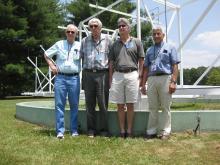The Jove meeting begins on Wednesday morning with a discussion of the Jove radio telescope. Throughout the day we will progress from the basics of radio Jove to more advanced systems. Along with discussions of receiver hardware and analysis software, you will hear about Jovian emissions, the source of these signals, and remaining mysteries as to how these signals are generated. Beginning at an introductory level suitable for the new Jove observer, we will progress to advanced receiving systems and analysis being performed by amateur and professional Jupiter radio astronomers.
On Wednesday morning, Dr. Jim Thieman will begin with an overview of the Jove program. Wes Greenman and Dick Flagg will describe the Jove radio telescope performance in terms of noise figure, dynamic range, gain and frequency stability, antenna beaming pattern, phasing, sensitivity and calibration. Jim Sky will reveal little known secrets of the ever-popular SkyPipe and Radio Jupiter Pro software. You will learn about the Jove data archive and new initiatives to share data with global virtual observatories.
Dr. Chuck Higgins will give the first of two talks focusing on Jupiter science, describing what has been learned using equipment similar to the Jove radio telescope. Chuck will tell us about the source regions, the Io effect, the radio rotation period of Jupiter, emission spectrum and more.
On Wednesday afternoon, Flagg, Typinski, and Sky will describe more advanced receiving hardware and software systems including spectrographs (analog and digital), polarimeters, and wideband antennas. You will learn more about the various forms of Jovian emissions: S-bursts, L-bursts, N-events and modulation lanes as well as propagation effects occurring in the interplanetary medium and earth’s ionosphere. Jupiter’s dynamic radio spectrum as viewed over a time scale varying from hours to a few hundred microseconds will be revealed.
Following Typinski’s mind-numbing tutorial on the fast Fourier transform, we will take a virtual tour of his observatory including a dual polarization spectrograph, a new tuneable wideband receiver and Dave’s wideband, dual polarization, beam steering antenna array.
The afternoon will wrap up with a presentation about the recent exploits of the SUG (a spectrograph users group).
The Thursday sessions begin with an extension of Jupiter radio science from the day before, and then the talks focus on results gathered with both amateur and professional radio telescopes. Dr. Kazumasa Imai will speak about the Japanese Agawa Radio Observatory. We’ll also have Stan Kurtz from UNAM, Mexico, discussing how Radio Jove is used there for research and education. Other research talks from longtime Radio Jove observers include N-events, accurate timing systems, the SL-9 comet encounter with Jupiter, new observations made with the Long Wavelength Array (LWA), and some solar radio science. The meeting concludes with an overview of the Juno mission to Jupiter and the future of the Radio Jove program.
In addition to the daytime talks, we plan to have the Jove radio telescope and additional equipment set up on the field most evenings. Join us for some hands-on, one-on-one discussions, both there and in the Drake Lounge.

